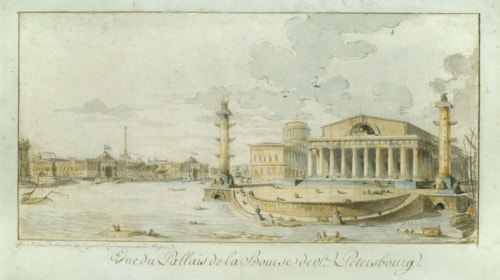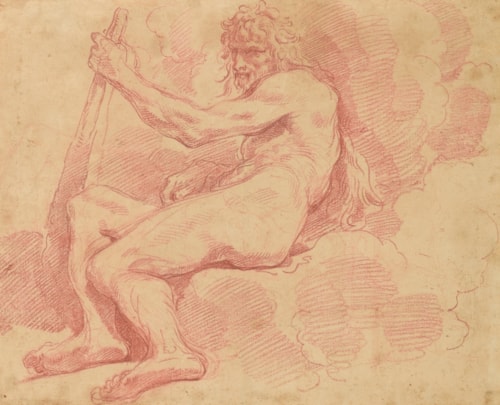pollinary Mikhailovich Vasnetsov
(Riabovo, Viatka 1856 - Moscow 1933)
Hunters on Horseback in a Pine Forest
signed in Cyrillic (lower left)
pencil and watercolour on paper
14 x 20.7 cm (5½ x 8⅛ in)
Apollinary Mikhailovich Vasnetsov captures the quiet stealth of two hunters as they move through the long grass of a forest. The two men, both of whom are on horseback, guide their steeds away from the viewer and through an archway created by two fallen pine trees. The men are dwarfed by these thin and lofty trees, which cover the hillsides as far as the eye can see. The stillness and calm of the image is emphasised by the cool, overcast conditions in this remote and isolated corner of rural Russia.
Vasnetsov’s art frequently depicts similar scenes of dense forest, Noon being one fine example. In a manner comparable to Hunters on Horseback in a Pine Forest, the figures are dwarfed by surrounding trees looming above them. Soft sunlight penetrates the overhead canopy, falling in shafts on the forest floor. Both works focus on the understated beauty of the forest; nature feels tranquil and untouched. They display the same masterful skill, evident in the free, broad brushstrokes and the vivid freshness of the colouring, and the same peaceful mood which is characteristic of so many of Vasnetsov’s landscapes.
Similarly Northern Territory, which shows a river landscape at dusk, has an overriding sense of quiet. Northern Territory takes a more panoramic view of the landscape, depicting pine trees stretching away into the distance. This focus on the vastness of the Russian countryside is something explored to a lesser extent in the mountainous background of Hunters on Horseback in a Pine Forest. The present work, as a document and celebration of the Russian landscape, is typical of Vasnetsov’s oeuvre.
Vasnetsov received his artistic training from his brother, Viktor Mikhailovich Vasnetsov, one of the leading Russian artists of his generation, who played an influential role in the evolution of Russian art away from nineteenth-century Realism. However, Vasnetsov’s mature work seems more influenced by the work of Vasily Dmitrievich Polenov (1844-1927). Polenov’s landscapes have the same freshness of colour, skilful composition and sense of tranquillity that characterises Vasnetsov’s work.
Together with his brother, Vasnetsov was a member of the Abramtsevo Colony, a centre for the Slavophile movement amongst the artistic community. Here he met and was influenced by some of the most esteemed of his contemporaries. The forested terrain around Abramtsevo can be seen in the present work. In addition to his epic depictions of the Russian countryside, Vasnetsov developed a type of historical landscape, his love of history and archaeology leading him to paint imagined depictions of medieval Moscow. He shared in common with many of his contemporaries, including Konstantin Korovin (1861-1939) and Valentin Serov (1865-1911), an interest in the Russian North. The scale of the mountainous pine forests provided endless subject matter as he portrayed the power and beauty of an untouched Russian landscape.
Apollinary Mikhailovich Vasnetsov captures the quiet stealth of two hunters as they move through the long grass of a forest. The two men, both of whom are on horseback, guide their steeds away from the viewer and through an archway created by two fallen pine trees. The men are dwarfed by these thin and lofty trees, which cover the hillsides as far as the eye can see. The stillness and calm of the image is emphasised by the cool, overcast conditions in this remote and isolated corner of rural Russia.
Vasnetsov’s art frequently depicts similar scenes of dense forest, Noon being one fine example. In a manner comparable to Hunters on Horseback in a Pine Forest, the figures are dwarfed by surrounding trees looming above them. Soft sunlight penetrates the overhead canopy, falling in shafts on the forest floor. Both works focus on the understated beauty of the forest; nature feels tranquil and untouched. They display the same masterful skill, evident in the free, broad brushstrokes and the vivid freshness of the colouring, and the same peaceful mood which is characteristic of so many of Vasnetsov’s landscapes.
Similarly Northern Territory, which shows a river landscape at dusk, has an overriding sense of quiet. Northern Territory takes a more panoramic view of the landscape, depicting pine trees stretching away into the distance. This focus on the vastness of the Russian countryside is something explored to a lesser extent in the mountainous background of Hunters on Horseback in a Pine Forest. The present work, as a document and celebration of the Russian landscape, is typical of Vasnetsov’s oeuvre.
Vasnetsov received his artistic training from his brother, Viktor Mikhailovich Vasnetsov, one of the leading Russian artists of his generation, who played an influential role in the evolution of Russian art away from nineteenth-century Realism. However, Vasnetsov’s mature work seems more influenced by the work of Vasily Dmitrievich Polenov (1844-1927). Polenov’s landscapes have the same freshness of colour, skilful composition and sense of tranquillity that characterises Vasnetsov’s work.
Together with his brother, Vasnetsov was a member of the Abramtsevo Colony, a centre for the Slavophile movement amongst the artistic community. Here he met and was influenced by some of the most esteemed of his contemporaries. The forested terrain around Abramtsevo can be seen in the present work. In addition to his epic depictions of the Russian countryside, Vasnetsov developed a type of historical landscape, his love of history and archaeology leading him to paint imagined depictions of medieval Moscow. He shared in common with many of his contemporaries, including Konstantin Korovin (1861-1939) and Valentin Serov (1865-1911), an interest in the Russian North. The scale of the mountainous pine forests provided endless subject matter as he portrayed the power and beauty of an untouched Russian landscape.





 contact
contact contact
contact +44 20 7313 8040
+44 20 7313 8040









